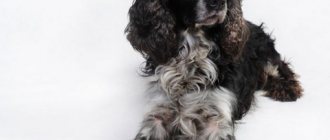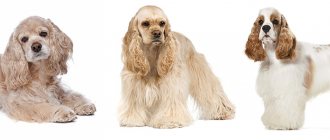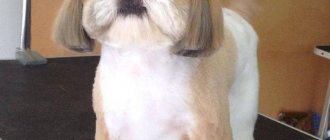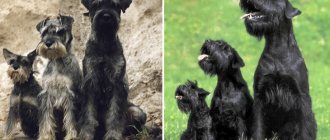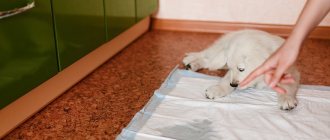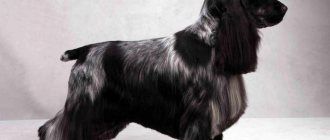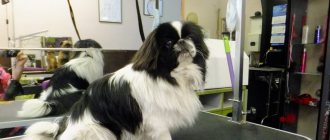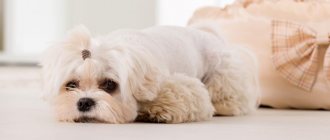Types of spaniels and their distinctive features
Such beauty needs to be looked after.
It is very difficult to talk about all the breeds belonging to this category - their total number is close to two dozen. So it’s worth briefly mentioning at least the most popular ones and those of greatest interest to breeders:
- The Russian Hunting Dog is a very intelligent and at the same time quite compact dog. With a height of about 45 cm, it weighs 10-18 kg. Ideal for hunting any bird.
- English is more compact than Russian and is intended, first of all, not for hunting, but as a companion.
- The Welsh Springer is a breed distinguished by its love not only for hunting, but also for children. At the same time, it can boast of significant size - with a weight of 16-20 kg it grows to 40-48 cm.
- Cavalier King Charles - despite its small size (weight about 8 kg and height 30-33 cm) is an excellent hunter. Moreover, it is better suited not for catching poultry, but foxes and badgers.
When getting a pet of any kind, you should know exactly how to cut a spaniel.
Story
The Russian spaniel is the youngest breed of Russian dogs. It originated in Russia at the end of the 19th - beginning of the 20th centuries, at the time of the formation in Europe of such breeds as the English Cocker and Springer Spaniels, through selection for outstanding hunting qualities and medium-sized different types of spaniels (Field, Sussex, etc.). The first mention of “Russian Spaniels” was recorded back in 1858 in the monthly hunting magazine “The Sporting magazine”[3]. Later, there were advertisements about puppies and missing Russian Spaniels in the New Zealand newspapers “Evening Post”[4][5] and “Auckland Star”[6].
One of the first spaniels in Russia was the black cocker spaniel Dash, imported at the end of the 19th century, owned by the hunting enthusiast Grand Duke Nikolai Nikolaevich. Afterwards, mainly from England, other cocker and springer spaniels were imported, which were actively used in breeding events (exhibitions, trials, breeding) of the Russian Hunting Club, the Moscow Hunting Society, the Society of Pedigree Dog Fanciers, the Moscow Society of Hunting Fans, the Reproduction Society hunting and commercial animals. Thanks to the few enthusiastic spaniels at exhibitions and the active use of spaniels in hunting, it was at this time that the first “Russian” spaniels appeared. One of them, the brown-piebald springer spaniel of Tsarevich Alexei Joy (English - joyful, cheerful), a descendant of Dash, brought to Russia. A section for “spaniels born in Russia” appeared at the exhibitions.
Because spaniels belonged mainly to aristocratic hunters, starting with the family of Emperor Nicholas II himself, then after the revolution of 1917, the bulk of the number of spaniels from hunting nurseries was exported (sold) abroad or went from hand to hand, and therefore the number of spaniels sharply decreased . But by the end of the 20s, the purchase of spaniels in Europe and their breeding in the RSFSR resumed. Important sires of that time, later appearing in many pedigrees of domestic spaniels, were the cockers Alba von Blumenthal (Germany) and Sammy of Wezemel (Belgium). In 1929, the first field tests of spaniels were carried out in the USSR.
In 1931, a section of spaniels was created in the Section of Blood Dog Breeding in Leningrad and from that moment on, clear and thoughtful selection and breeding work began with the emerging breed, which was carried out by Miklashevsky S.P., Linchevsky S.N., Shwede D.L., Lyubosh A. .WITH. By the end of the 1930s, a variety of spaniels appeared in Moscow, Leningrad and Sverdlovsk that did not fit into any specific spaniel breed standards, but were not yet standardized into the modern Russian hunting spaniel.
During the Second World War, the spaniel population in Leningrad, one of the main centers for working with the new breed, was almost completely destroyed. Scrupulous, targeted breeding work after the Second World War led to the consolidation of the phenotype and the adoption in 1951 of the original standard of the “Russian” spaniel.
In the 60-80s, the breed was popular among Soviet hunters due to its unpretentiousness in apartment conditions, ease of transportation in public transport and excellent hunting qualities in the Russian landscape. This was facilitated by the propaganda of Russian spaniels by famous writers - M.M. Prishvin (4 of his spaniels are known) and V.V. Bianki (3 spaniels). Children's book “Tomka” by writer and artist E.I. Charushina about the spaniel puppy - without exaggeration, was known to every child of the Soviet Union. Large breeding centers with clubs at hunter societies are being formed in Leningrad, Moscow, Sverdlovsk, Novosibirsk[1].
The popularity of the breed in Russia was increased even more in the early 1990s by the annual Moscow Dog Show. This breed became one of the most popular, along with the Irish Setter, which did not save it from a sharp decline in the population to a minimum in the mid-90s.
In the 2000s, with the support of RFOS and RORS, the breed experienced a new rise. The Russian hunting spaniel remains the most popular breed among hunting spaniels. Thanks to the comparative ease of movement, there is a more active exchange of “blood” between regions. All-Russian competitions and exhibitions attract a significant number of participants. The main breeding centers for the breed are still Moscow, St. Petersburg, Yekaterinburg, and Novosibirsk. There are quite large and actively developing “nests” in Samara, Saratov, Tambov, Yaroslavl, and other cities of Russia. There are sections and clubs in Ukraine, Belarus, Kazakhstan, Estonia.[7] In 2002, the Russian Spaniel Club[8] was created in the USA to increase knowledge about the breed outside of Russia and the ability of owners to register their dogs.
What haircut to choose to make it easy to care for your cocker
Different breeds have different coats not only in color, but also in length and degree of hardness. Therefore, it will not be superfluous to figure out in advance which haircut is suitable for a particular pet. After all, not only external beauty, but also the complexity of care depends on this.
English cocker spaniel
Perhaps, it is the haircut of the English Cocker Spaniel that is the most difficult.
And it is very difficult to care for. The shortest fur is left on its face and head. Slightly longer – along the back and on the shoulders. Finally, on the chest, ears, belly and paws, the hair is left as long as possible - just trimmed a little to make the dog look really attractive. Note! Particular attention should be paid to the hair on the chin. If it is long, it will constantly get dirty while eating.
Russian cocker spaniel
But this dog seems to have been created by nature in order to be as easy to care for as possible. It is generally advisable not to cut it. It is enough to just trim the coat if it grows unevenly, bathe and comb it regularly to prevent tangles from forming.
Beautiful, well-groomed dogs
American Cocker Spaniel
But cutting an American spaniel is a real art. There are many ways to make this dog look elegant and attractive. Thick, abundant and fast-growing wool allows you to experiment and create a variety of styles.
But if you adhere to the standards, they will be the same as for an Englishman - short hair on the face and head, medium on the shoulders and back, long on the paws, belly, ears and chest.
What to feed for the first 3 months?
For at least 2-3 weeks, and preferably 30-40 days, the main food for puppies should be mother's milk.
The exception is when this is impossible for some reason, then the breeder needs to feed the entire litter himself, using unsweetened and lactose-free infant formula or, better yet, special bitch milk substitutes, for example, Royal Canin Babydog Milk.
After the main lactation period, i.e. about a month after the puppies are born, they need to start giving complementary foods in the form of ground vegetables, fermented milk products or soaked dry food.
At 2 months, the puppy should be familiar with most of the foods allowed for spaniels in order to be as prepared as possible for moving to a new home.
New products must be introduced into the menu gradually, observing how the puppies’ bodies react to them and whether there are any negative reactions.
Grooming: mandatory dog care procedures
Of course, grooming a spaniel is not limited to just a haircut. You need to regularly bathe him, trim his nails, brush his teeth and ears, and comb him. True, if you turn to specialists, you will have to regularly shell out a lot of money.
Estimated cost of services
Basic grooming prices relevant for spring 2020:
- Bathing and drying – 1500-2000 rubles.
- Haircut and trimming – 2000-3000 rubles.
- Complex (bathing, drying, trimming nails, cleaning ears, haircut) – 3000-5000 rubles.
Therefore, it is not surprising that many breeders are interested in how to trim a spaniel at home with scissors.
How to train correctly and what commands to teach?
Spaniels are intelligent dogs that are easy to train . Puppies quickly adapt to new conditions, adjusting to the rules established in the house and the owner’s lifestyle.
However, they need proper upbringing; you should not expect that the pet will learn everything on its own.
There are several basic recommendations that need to be taken into account when raising a spaniel.:
- It is best to start training when the puppy is 5-6 months old, this is the optimal time until the dog’s character is fully formed;
- It is necessary to work with your pet regularly - this is the only way to achieve positive results in the shortest possible time;
- The spaniel should be provided with sufficient physical activity and training should begin when the pet is reasonably tired, so as not to be distracted from activities;
- It is better to conduct training in a playful way;
- you cannot shout at the puppy or hit him;
- For correct execution of a command, the pet must be rewarded with praise and treats.
Representatives of this breed are friendly towards everyone, so it is necessary to show the puppy that he needs to behave with restraint with strangers, do not allow him to jump on passers-by or sniff them.
It is also important to teach your dog at least basic commands . First of all, you need to accustom your pet to its nickname, saying it out loud as often as possible when addressing it.
After the puppy begins to associate himself with the chosen name, you need to teach him the “Come to me” command, calling the spaniel by name and treating him with a treat when he comes.
You should also call him by name before feeding - this will help reinforce the dog’s positive associations with this command.
Place training is another important command . You should arrange a personal place for the dog where it will sleep and take the puppy there, saying the command “Place”.
When the baby remembers this and clearly understands where exactly his personal place is, this command can be a little more complicated: you need to leave the pet in any other place, say the command and leave, making sure that the puppy does not follow.
It is also important to master the commands “Fu” and “No”, pronouncing them loudly and clearly when the pet does something forbidden; at the same time as the command, you can take it by the withers and shake it slightly.
For the “Sit” command, you need to show the puppy a treat so that he raises his head and sits down; you can easily press on his croup and clearly pronounce the command.
Using the same principle, the “Lie down” command is mastered, only the puppy’s position changes..
In addition, it will not be superfluous to master the commands “Give me your paw”, “Nearby”, “Show your teeth”, and hunting dogs also need to be trained in fetching.
How to cut a spaniel's hair at home with scissors
It is advisable to carry out the first procedures under the supervision of experienced experts. And in general, taking a few lessons will be very useful. It's really an unusual job to cut a spaniel. Of course, you need to decide in advance what kind of hairstyle your pet should have.
Master at work
Tools for cutting and combing
To ensure that the work takes a minimum of time and effort, and also does not cause discomfort to the owner and pet, it is imperative to have high-quality tools on hand:
- A machine with attachments for wool of different lengths.
- Several types of scissors (regular, for tangles).
- Puhoderku.
- Combs with different distances between teeth.
It’s worth noting right away that tools for cutting people’s hair are not suitable here. After all, the structure of hair is not identical to the structure of wool, so although scissors and clippers are similar, they have certain differences.
Healthy! When working, you should not use metal combs - only high-quality, durable plastic, so as not to harm the hair.
Characteristic
Strong, active, persistent dog. She is selflessly devoted to her owner and is ready to carry out any of his orders, although she is quite emotional and active. A Russian Spaniel swims and dives to retrieve a wounded bird. Hunts and tests on swamp, field and forest game (previously the breed was even tested on the blood trail). Has good instincts and endurance. Can be a watchman (although this is extremely undesirable) if provided with the necessary physical activity. It can be trained very well, but without exercise it can become hyperactive. Some male dogs can be dominant, but with proper training this can be corrected. Calm, obedient, affectionate domestic dog, absolutely loyal to children and other pets.
General rules
To make clipping your spaniel less difficult, it’s a good idea to learn a few simple tips:
- Provide a table or other support for the dog during the procedure - the master should not bend over it, otherwise his back will soon hurt.
- Carry out the procedure at least 3 times a year - otherwise the dog will become overgrown unnecessarily.
- Before grooming, the dog must be washed with a special shampoo and then dried - the coat will become softer and more manageable, and it will be easier to get rid of tangles.
Keeping this simple scheme in mind, you can easily achieve ideal coat condition.
The dog hasn't visited the salon for a long time
Hunting
Russian spaniels are designed for hunting game birds:
- swamp-meadow game (great snipe, snipe, humpback, corncrake, marsh hen (crakes, shepherdess);
- field game (quail, gray partridge, pheasant);
- upland game (woodcock, black grouse, wood grouse, white partridge);
- waterfowl (duck).
While searching for the bird, they work within gunshot and energetically lift it onto the wing. Their small stature, lack of stance and great hunting passion make them indispensable when hunting in support structures, on running birds, and quite effective when hunting any other feathered game. After a successful shot, the spaniels find and return the dead game to the hunter.
Distinctive abilities are:
- find a bird, using its smell or the smell of its track to rise to the shot and to search for a dead bird or wounded bird;
- speed and energy of the search;
- the ability to rationally, taking into account conditions, search areas within a rifle shot;
- sharp animation, rapid wagging of the tail at the moment of sensing the bird or its tracks, and a quick, energetic movement in the direction of the bird, ending with a throw to lift it onto the wing;
- energy and reliability of work in searching, when working on poultry, picking up wounded animals and performing feeding in any conditions, including in “strong places” and in water;
- the ability to quickly and reliably bring found game.
Russian spaniels also hunt white and brown hares.
Notes
- ↑ 1,01,1 Parshev A.P., Rusina I.B. “Historical sketch of the early history of the Russian spaniel”
- Russian Hunting Spaniel Breed Standard (RKF 2020)
- The Sporting magazine / January 1858
- Evening Post / December 21, 1891
- Evening Post / September 8, 1899
- Auckland Star / 23 March 1929
- Rusina I.B. “Russian hunting spaniel: past, present, future” / Dog Friend Magazine No. 8, 2011
- Russian Spaniel Club
- Russian hunting spaniel Breed standard (1966)
- Russian Hunting Spaniel Breed Standard (Project 2000)
- Russian Hunting Spaniel Breed Standard (Project 2015)
